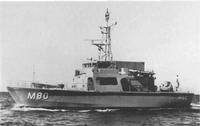


Chapter 13
I Colonial Origins
II First World War
III Between The World Wars
IV The Second World War
V Post-second World War
VI After The Joint Project
VII Science And Decisions At The Top
VIII Armed Services Technology
i Army Design
ii Navy Design
iii Air Force Investigations
iv Food Science
IX New Tasks And Projects
X Transfer Of Research And Development
XI Acknowledgement
References
Index
Search
Help
Contact us

Navy Design
The nature of naval equipment tended to limit the scope of Australian support. The Naval Technical Service undertook, in the 1960s, the planning in detail of a family of light destroyers, using a common hull design, to fulfil various missions with different equipment fits. The roles included anti-submarine, anti-aircraft and patrol interdiction and fire support. Specialised equipment would be required such as the Ikara anti-submarine missile system, anti-aircraft guided missiles, electronic warfare systems, information and control systems for helicopter operation and associated patrol vessels fuel systems. A contract was issued to a British firm to undertake specialised design, but the project was cancelled in 1972 on the score of high potential cost and high risk. Another vessel, a mine hunter, offered scope for incorporating advanced technology.[69] A catamaran configuration having composite glass fibre and rigid plastic foam construction was conceived. Tests carried out by the DSTO ensured that this form of construction could withstand the loading imposed by close under water explosions. Naturally the use of ferrous materials had to be avoided as far as practicable and the location of electric cables arranged to avoid the creation of electro magnet induction loops within the earth's magnetic field. Construction of two 170-tonne prototype mine hunters was ordered in 1983 from Carrington Slipways Pty Ltd of Newcastle. A high technology sub-system for remote destruction of a detected mine was to be supplied by a French company, there being no tenders received from Australian firms.
Organisations in Australian Science at Work - Carrington Slipways Pty Ltd, Newcastle
 |
Australian Academy of Technological Sciences and Engineering |  |
© 1988 Print Edition page 963, Online Edition 2000
Published by Australian Science and Technology Heritage Centre, using the Web Academic Resource Publisher
http://www.austehc.unimelb.edu.au/tia/947.html